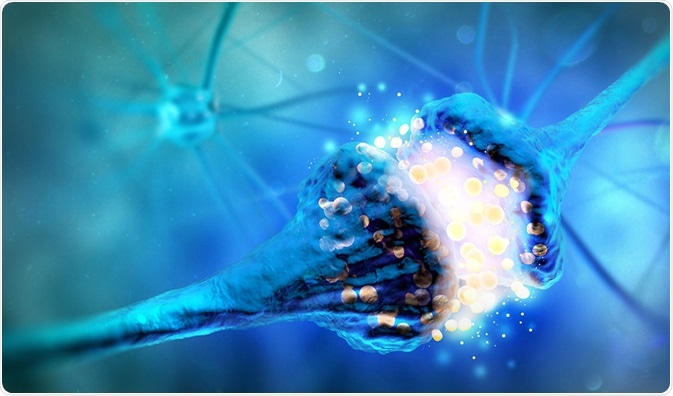By Jeyashree Sundaram, MBA
G-protein coupled receptors belong to the largest superfamily of transmembrane spanning (TMS) proteins in the vertebrate genome.

Credit: Andrii Vodolazhsky/Shutterstock.com
They are highly diverse in sequence, but contribute the same topological structures. An essential function of GPCR is cell signaling through extracellular signals, such as neurotransmitters and hormones.
GPCRs are also essential for relaying extracellular signals such as neurotransmitters and hormones to cells. They mediate intracellular signals by coupling with particular G proteins.
GPCRs are receptors for amino acids, glycoproteins, amines, peptides, fatty acids, Ca2+ ions and sensory receptors for various exogenous ligands such as bitter molecules, odorants, pheromones, light photons, and sweet tastings.
Thousands of GPCRs have been identified in the human genome, comprising around 350 receptors for growth factors, hormones, and some endogenous ligands, while 150 receptors still remain unidentified.
Origin of the seven transmembrane spanning core
GPCRs consist of seven transmembrane (7TM) spanning regions. Signal transduction by GPCRs is a characteristic feature of eukaryotes, however proteins of 7TM receptor however have also previously been found in prokaryotes.
Prokaryotic proteins with 7TM regions include light-sensitive bacteriorhodopsins, halorhodopsins, and proteorhodopsins. These proteins carry out energy harvesting without photosynthesis in bacteria and archaea. Bacteriorhodopsin, the oldest protein present in prokaryotes, has a conserved domain and crystal structure analogous with the topology of seven transmembrane GPCRs.
The phylogenetic relationship between 7TM and bacteriorhodopsin suggests that the eurkaryotic glutamate receptor is highly homologous to bacteriorhodopsin. Thus, 7TM spanning receptors are likely to have evolved from the topology of bacteriorhodopsin.
Origin and diversification of GPCR families
In 1994, Findlay and Attwood segregated the GPCR superfamily into six classes (A–F) based on their functional similarity and sequence alignment.
This was followed by the GRAFS classification (Glutamate, Rhodopsin, Adhesion, Frizzled/Taste2, Secretin) which relates to the 7TM spanning GPCRs in the human genome.
The Rhodopsin (Class A) family is the largest family, comprising 683 members present in humans. This family has distinct features that are short wide ranging amino-termini and ligand interactions. The Adhesion (Class B) receptors comprise of long amino-termini with multiple domains.
The Glutamate (Class C) family is characterized by long amino-termini that serve as the region for endogenous ligand binding. The Frizzled (Class F) receptors contain long amino-termini with cysteine-rich protein.
Glutamate family
Much of the functional evidence and genomic data currently available is based on glutamate family members found in Geodia cydonium and Dictyostelium discoideum, whose evolution was 600 million years ago. The glutamate family is therefore regarded phylogenetically as the oldest family of GPCR.
The Venus fly trap module (VFTM) belongs to this group and is characterized by a long amino-terminal domain which specifies ligand binding and has identical sequence to the periplasmic binding proteins of bacteria.
The VFTM is regarded as unique, as glutamate-dependent activation is not observed in D. discoideum and is only present in G. cydonium at millimolar concentrations. This indicates that signaling of glutamate by this family has appeared initially in metazoan evolution.
In protozoan forms of glutamate receptors, binding of amino acid (glutamate) is most important. While in vertebrate evolution, the glutamate family gave rise to taste, calcium sensing, fish, and pheromone olfactory receptors.
Adhesion family
The adhesion family includes fundamental features, such as long N-terminus domains, epidermal growth factor domains, and GPCR proteolytic (GPS) domains that can be identified in metazoan species.
Monosiga brevicollis is a unicellular choanoflagellate is the closest metazoan that has a GPS domain of adhesion GPCR. Similarly, sequences distantly belonging to adhesion GPCRs can also be found in the genomes of plant and fungi.
In mammals, adhesion family expands to about 31 members in mouse and 33 members in human.
The adhesion family is highly preserved in all bilaterally symmetrical animals and members perform an important part in tissue development. This includes the Drosophila flamingo night receptors and cadherin-like family. The adhesion family members are also responsible for maintaining tissue polarity and cell control, and are involved in frizzled signaling.
Secretin family
The Secretin (class B) family shares some common features with the adhesion family. Secretin receptors comprise a 7TM core and amino-terminal hormone binding (HRM) domain, both of which are involved in the binding of peptide hormones.
Secretin receptors can be identified in most bilaterians, but not in older metazoans. In mammals, the secretin family has a complicated genomic structure with different introns.
In mammals, secretin receptors contain highly conserved bisulfide bridges inside the amino terminus that play an important role in ligand binding.
Frizzled family
The frizzled family is found in cnidaria, placozoa (Trichoplax adherens), and sponges. This family is thought to have evolved in multicellular metazoan.
Frizzled receptors are highly conserved across all organisms containing GPCRs. They play a major role in ontogenesis of eumetazoa, cell multiplication regulation, gastrulation, cell polarity, and tissue development.
Rhodopsin family
The rhodopsin family comprises the largest subfamily of GPCRs in vertebrates. In humans, there are 683 members segregated into four major groups, namely, α-, β-, γ-, and δ-groups, which can be further divided into 13 subfamilies.
The receptors of this family are involved in the binding of ligands which comprise small molecules such as purines, amines, peptides, large glycoproteins, and lipids.
The conserved feature of the rhodopsin family is the 7TM spanning core, which is found in all bilateral animals, and also in cnidaria. This suggests that the rhodopsin family evolved 570–700 million years ago.
Advanced sequencing methods and development of genotyping have greatly increased the available genetic data for both the growing and individual species from various populations. One of the most interesting features to be elucidated from genetic studies is the adaption of GPCRs to new sensory functions, which provided a major advantage in human evolution.
Further Reading
Last Updated: Feb 26, 2019